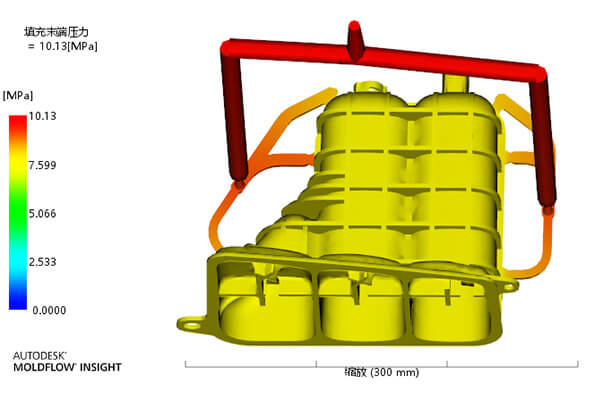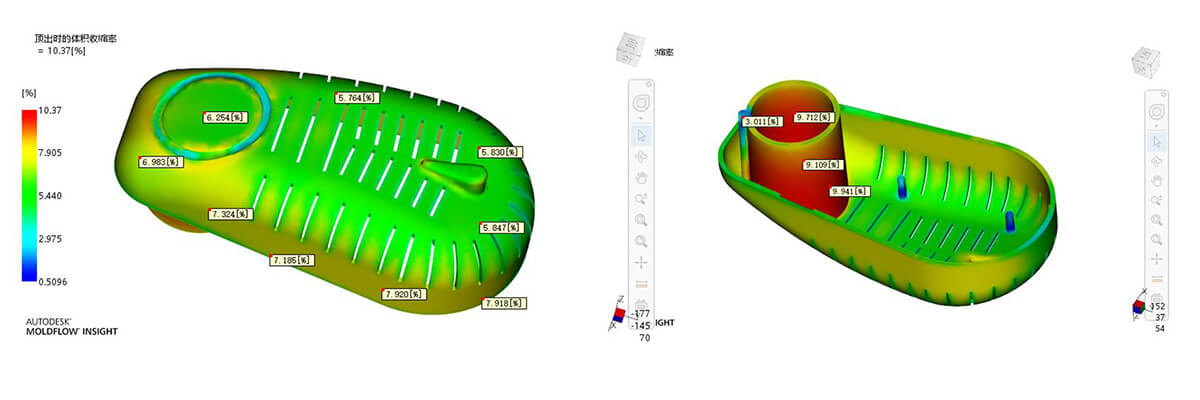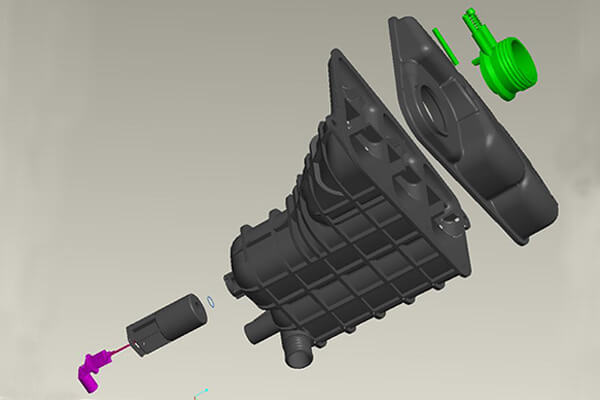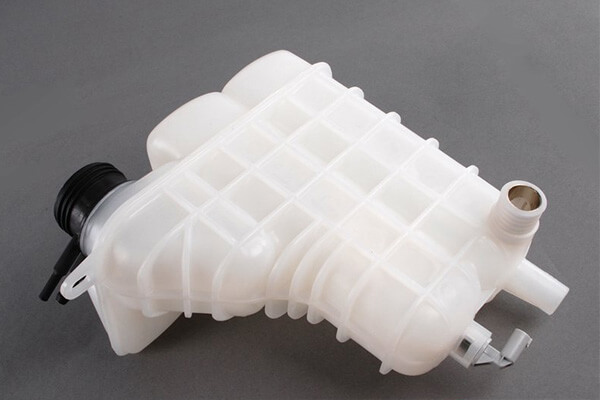Mold Flow Analysis Greatly Improves Injection Molded Products’ Quality
Mold Flow Analysis (MFA) software simulates the flow of plastics to improve part and mold design and produce flawless, high-quality products. Injection molding is a manufacturing process used to manufacture various products in a short period of time. For an efficient manufacturing process, precise molds are critical in injection molding as they ensure consistent quality of injection molded parts. The quality of the mold can be improved by performing mold flow analysis and testing on the mold. As a result, MFA has become an integral part of any injection molding design project due to its impact on mold quality, product performance and appearance.
What is Mold Flow Analysis?
Mold Flow Analysis is a software-based simulation technique used in the field of injection molding. It predicts and analyzes the flow of plastic materials during the injection molding process. This analysis is usually performed before the actual injection molding.
MFA makes it easy to optimize mold designs to produce superior and consistent parts, shorten production cycle times, minimize material waste, and ultimately produce high-quality products with fewer defects. This technology produces a visual representation of the flow, cooling and solidification of plastic in the mold based on input parameters such as material properties, mold design, processing conditions and part geometry.
Overall, MFA is a powerful tool that plays a vital role in the plastic injection molding industry. By understanding mold flow analysis, designers and engineers are able to make informed decisions and optimize their designs for successful, efficient production.
Tools and Software for Mold Flow Analysis
Mold Flow Analysis relies on specialized software and tools to simulate and analyze the behavior of molten plastic during the injection molding process. Various tools and software options are available to meet the diverse requirements of Mold Flow Analysis, catering to design engineers seeking integration with CAD platforms and advanced users who demand in-depth analysis of complex injection molding processes. The selection of the appropriate tool depends on your specific project requirements. Here are some renowned tools and software commonly employed for Mold Flow Analysis:
Autodesk Moldflow
Autodesk Moldflow is a comprehensive suite of software tools for injection molding simulation. It provides capabilities for design validation, optimization, and analysis of plastic parts and molds. It’s known for its user-friendly interface and extensive material databases.
Moldex3D
Moldex3D is a widely-used simulation software that offers in-depth analysis of plastic injection molding processes. It covers various aspects of molding, including flow analysis, warpage prediction, cooling analysis, and more.
SolidWorks Plastics
SolidWorks Plastics is an add-on module for SolidWorks CAD software. It enables users to simulate the injection molding process directly within their SolidWorks environment, making it convenient for design engineers.
PTC Creo Mold Analysis
PTC Creo Mold Analysis is a module within the PTC Creo CAD software suite. It provides tools for analyzing plastic flow, cooling, and warpage, helping designers optimize their injection molding designs.
SIGMASOFT
SIGMASOFT is known for its comprehensive simulation software for injection molding. It offers advanced capabilities for simulating complex processes, including multi-component molding and rubber injection.
Moldflow Insight
Moldflow Insight, part of the Autodesk Moldflow family, is a specialized tool for advanced flow analysis and optimization of injection molding processes. It provides detailed insights into material behavior.
How Does Mold Flow Analysis Work?
Mold Flow Analysis is a sophisticated engineering tool that is used to check designs and generate color maps of various properties of the actual mold flow. Injection molding is much more complex than simply designing a part and relying on prefabricated molds to produce the product. Some mistakes may occur during this process, which will affect the quality of the part. By using mold flow analysis, the probability of these errors can be reduced. The following is a step-by-step analysis of how mold flow analysis works:
- Geometry Import: The first step is to import the CAD geometry of the part and mold into the MFA software. This includes the 3D models of the part, runner system, gates, and cooling channels.
- Material Selection: The software allows the user to select the appropriate material for the simulation. Material properties such as viscosity, melt temperature, and thermal conductivity are specified.
- Mesh Generation: The software automatically generates a computational mesh, dividing the geometry into small elements or cells. This mesh is used to discretize the domain and solve the mathematical equations governing fluid flow and heat transfer.
- Boundary Conditions: The user defines the process parameters such as injection speed, pressure, and cooling time. These parameters are applied as boundary conditions for the simulation.
- Simulation: The MFA software solves the mathematical equations using numerical methods to simulate the flow of molten plastic within the mold cavity. It considers factors like flow rate, pressure, temperature, shear stress, and cooling effects.
- Analysis Outputs: Once the simulation is complete, the software provides visual outputs and numerical data for analysis. This includes flow front progression, temperature distribution, pressure distribution, and other relevant parameters.
- Design Optimization: Based on the analysis results, the designer can identify potential issues such as flow imbalances, air traps, weld lines, sink marks, or excessive cooling. Adjustments can be made to the mold design, gate locations, cooling channels, and process parameters to optimize the part quality and manufacturing efficiency.
- Iterative Process: MFA is often an iterative process. Design modifications are made based on the simulation results, and the analysis is rerun to validate the changes. This iterative approach helps refine the mold design and achieve the desired part quality.
By simulating the flow behavior of plastic materials, mold flow analysis enables designers and engineers to predict and optimize the injection molding process. Sungplastic utilizes cutting-edge technology and expertise to help you design and produce perfect plastic parts.
When Should Mold Flow Analysis be Used?
As evident from the previous explanation, Mold Flow Analysis is conducted as a precursor to the tooling process. This proactive step is taken to detect potential issues or technological shortcomings before committing valuable resources like time and capital to the final product’s production. Sungplastic uses mold flow analysis to prevent production waste and ensure timely fulfillment of orders. By proactively assessing production feasibility, the production of high-quality end products is guaranteed while minimizing resource waste in the manufacturing process.
However, does every application require mold flow analysis? The answer is: not really. The following factors can help you decide whether to use MFA in your application:
Product Complexity
The complexity of a product’s geometry directly correlates with the advantages offered by Mold Flow Analysis. Why is this the case? When a product’s design becomes more intricate, the flow of materials becomes less predictable.
Stringent Tolerance Requirements
Demanding injection molding tolerance requirements often pose challenges to plastic injection mold designers. Having software that can assess and demonstrate whether a product will meet specifications before initiating the tooling process is a valuable asset.
Unconventional Materials
Engineers are well-versed in predicting the fill patterns of standard materials. However, for unconventional materials, particularly those containing fillers, upfront analysis proves highly beneficial.
Project Scale
Clearly, a project must meet specific financial criteria to justify the allocation of resources—time, software, and expertise—required for conducting these tests.
Why MFA is important in Optimizing Injection Molding Process?
Injection molding is a widely used manufacturing process for producing a vast array of plastic components and products. To achieve an efficient and cost-effective production process, precision in mold design is paramount. This is where Mold Flow Analysis steps in as a game-changer, significantly influencing the entire injection molding process. The key role of mold flow analysis in optimizing injection molding is described below:
Design Refinements
MFA substantially reduces errors and missteps during the mold design phase, facilitating the creation of high-quality products. Consequently, this allows for the exploration of diverse designs, as well as effortless design enhancements by identifying new adjustments and solutions.
Predicting Part Defects
Rectifying errors in product design can be a costly affair. Undetected flaws can lead to expensive plastic injection molding defects, such as cracking, bubbles, color line, shrinkage, gloss defects, silver marks, injection weld line, chatter marks, and swelling. Reproducing defective products necessitates starting from scratch, incurring additional costs.
With moldflow analysis, it becomes possible to anticipate where defects may arise during part production before they occur. Consequently, irregularities can be addressed before actual product manufacturing.
Optimizing Gate Position
The placement of gates is a critical aspect of injection molding. Gates act as entry points for molten plastic into the mold, where it cools and takes its final form.
Incorrect gate positioning can lead to insufficient filling of molten plastic in certain areas of the mold. Inaccurate gate placement results in imperfect products due to uneven distribution of molten plastic.
However, moldflow analysis allows for the optimization of gate positions through the analysis of plastic flow. This enables the precise determination of the ideal location for each gate in the mold, ensuring even distribution of molten plastic.
Predicting Fill Patterns
Beyond gate positioning, moldflow analysis can also predict and identify fill patterns. Predicting fill patterns involves simulating the flow of molten plastic into the mold, offering insight into the final product’s appearance prior to actual production.
Plastic flow analysis empowers engineers to anticipate fill patterns and make more effective mold redesigns.
Shrinkage Rate Measurement
Injection molding companies must grasp the concept of resin shrinkage rates. This is due to the fact that plastic materials undergo temperature fluctuations, transitioning from intense heat to rapid cooling. Most products experience some degree of shrinkage during the cooling phase.
Moldflow analysis has the capability to measure shrinkage rates for a wide array of plastics, spanning thermoplastics to thermosets. Sungplastic makes full use of this information when selecting the type of resin and considering the shrinkage rate of the product to customize high-quality plastic parts for customers.
Enhancing Product Quality
The use of moldflow analysis aids engineers in elevating the quality of their products. By forecasting the flow of molten plastic, design engineers can make design adjustments that enhance the manufacturing process.
Injection molding allows for the production of numerous high-quality products. Utilizing moldflow analysis permits engineers to maintain efficiency and streamline the injection molding process, ultimately reducing the likelihood of errors and improving product quality.
Reduced Lead Time
In injection molding, lead time signifies the duration between the initiation of the injection molding process and the availability of the product for distribution. To meet customer demands and efficiently manage high-volume market distribution of critical plastic components, minimizing lead time is imperative.
Numerous factors can impact lead time, with defects in injection molding being a common culprit. However, moldflow analysis can curtail lead time by early detection of potential defects before actual production commences.
Parameters and Variables During Mold Flow Analysis
During the mold flow analysis process of plastic injection molding, several parameters and variables need to be carefully considered and analyzed to ensure the efficiency and quality of the molding process. These include:
- Injection Speed: The speed at which molten plastic is injected into the mold. Controlling injection speed is critical to achieve the desired fill pattern and prevent defects such as cavitation or ejection.
- Injection Pressure: The force applied to push the molten plastic into the mold cavity. It’s important for maintaining consistent fill pressure and preventing issues like short shots.
- Melt Temperature: The temperature at which molten plastic enters the mold. Proper melt temperature ensures that the plastic flows smoothly and uniformly.
- Mold Temperature: The temperature of the mold itself. Mold temperature affects the cooling and solidification of the plastic. It must be controlled to prevent warping and other defects.
- Cooling Time: The time it takes for the plastic to cool and solidify inside the mold. Proper cooling time is essential for preventing sink marks and ensuring dimensional stability.
- Gate Location: The point at which the plastic enters the mold cavity. The gate’s size and location impact the flow pattern and should be optimized to prevent weld lines and air traps.
- Part Design: The geometry of the plastic part, including wall thickness, features, and undercuts. These factors affect how the plastic flows and solidifies in the mold.
- Material Properties: Characteristics of the plastic material, such as viscosity, melt flow index, and thermal conductivity, influence how it behaves during molding.
- Cavity Pressure: Monitoring the pressure inside the mold cavity during injection helps detect variations and ensures consistent part quality.
- Fill Time: The duration it takes for the mold cavity to fill completely with plastic. It’s essential for preventing short shots and ensuring uniform filling.
- Flow Front Progression: Tracking how the plastic flows through the mold cavity over time. Understanding flow front progression helps identify potential issues like uneven filling.
- Venting: Adequate venting ensures the escape of air or gases from the mold cavity during injection to prevent air traps and voids.
- Shear Rate: The rate at which adjacent layers of plastic move relative to each other. High shear rates can lead to material degradation and should be controlled.
- Warpage and Shrinkage: Analyzing how the plastic part may warp or shrink as it cools and solidifies. Proper design and processing adjustments can mitigate these issues.
These parameters and variables are carefully considered and adjusted during Mold Flow Analysis to optimize the injection molding process, improve product quality, and reduce defects. Accurate simulation and analysis help ensure that the final molded parts meet design specifications and quality standards.
How Material Flow Differs by Resin
Depending on the injection molding plastics‘ inherent properties, their behavior within the mold can vary. Plastics that exhibit favorable flow characteristics encompass:
- Polypropylene (PP)
- Low-density polyethylene (LDPE)
- High-density polyethylene (HDPE)
- Nylons (PA)
- Polystyrene (PS)
Our mold flow analysis endeavors to identify challenges that may arise when working with these difficult flowing materials, as well as addressing concerns such as thin walls and intricate geometries. We provide solutions aimed at enhancing flow and moldability.
Mold Flow Analysis For Plastic Injection Molding Service-Sungplastic
When it comes to plastic manufacturing, precision and efficiency are critical. MFA can just meet these requirements. It plays a vital role in modern manufacturing, especially in plastic injection molding. It can ensure the consistency of product quality, effectively control costs, and identify potential problems in advance.
Sungplastic is a leading provider of mold flow analysis services, with cutting-edge technology and expertise, providing comprehensive plastic molding manufacturing solutions to ensure the highest quality of your plastic parts. Our success stories spanning industries from automotive to electronics demonstrate how Sungplastic’s mold flow analysis services have revolutionized plastic manufacturing. Partner with Sungplastic to unlock the potential of mold flow analysis and take your plastic manufacturing to new heights for superior product quality and efficiency.
About Sungplastic
Sungplastic is a plastic product manufacturer with rich experience in injection molding. According to the different product development requirements, we flexibly adjust the manufacturing process to achieve high quality, high efficiency and more economical.
We offer a variety of manufacturing services: Rapid Prototyping, Tool Making, Injection Molding, Product Design and Development, CNC Machining and Metal Stamping. You can choose from a variety of plastics, silicone rubber, or metal for your product. Regardless of mass production or small batch customization, Sungplastic has always been committed to providing assured, efficient and more economical one-stop processing services for your projects.
Contact us for a free quote and project review.
Get a free quote and design analysis today.
We’ll reply you within 6 working hours. We respect your privacy.




